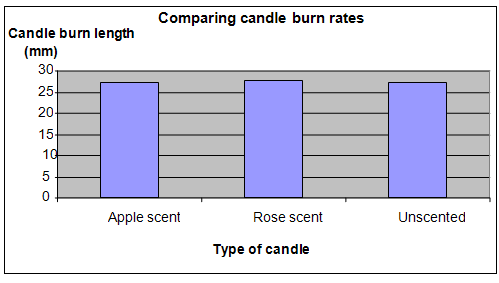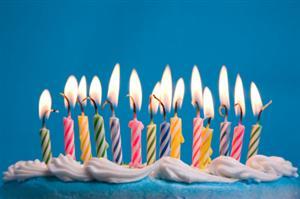| Complexity level: | 6 |
| Project cost ($): | 30 |
| Time required: | 1 hour to prepare, 1 hour for the science project experiment |
| Material availability: | Easily found. Candles can be purchased at a supermarket or department store. |
| Safety concerns: | Be careful when handling fire. Ensure that the experiment is conducted in a well-ventilated laboratory or in a safe location, with no flammable materials lying around. Adult assistance is required. |
Hypothesis
Unscented candles burn more quickly than scented candles.
Overview
Candles
Candles are a convenient way of providing light and heat when no electricity is available. They are normally made from paraffin wax with a wick in the middle. Candles can also be made from soy wax or other plant wax, animal fat or bee wax. Wax acts as a fuel to keep the candle burning. The wick has to be an absorbent twine with strong capillary ability.
When the wick of a candle is lit, the heat from the flame will melt the wax surrounding the wick. The melted wax will be absorbed by the wick and the capillary action will pull the wax upwards. When the wax approaches the flame, it will start to vaporize and the vaporized wax will start to burn. The wick itself will not burn because the vaporizing wax will cool the wick.
Candle manufacturers produce both scented and unscented candles. Common scents used in candles include kitchen aromas such as vanilla, fruit scents, flower scents, spa scents like green tea and ocean breeze. Candles are also found in a variety of colors, shapes and sizes.
Scientific Terms
Materials
- The materials required for this science project5 unscented candles
- 5 rose scented candles
- 5 apple scented candles
All of the 15 candles should have the same diameter, length and be made by the same manufacturer
- A ruler
- A caliper
- A stopwatch
- A box of matches or lighter
Procedure
1. For this experiment, the independent variable is the type of candle used – unscented, rose scented and apple scented. The dependent variable is the reduction in the candle’s length after 30 minutes. This is determined by measuring the height of the candle before and after allowing it to burn for 30 minutes. The constants (control variables) are the length of the candle, the diameter of the candle, the allowed burn time and the room temperature.
2. The three types of candles are labeled according to their scents and numbered from 1 to 5 for each type. Their total length and diameter is measured using a ruler and caliper for comparison. Any candle found to have a deviation of more than 1 mm in diameter is replaced with a new candle. All of the candle heights are recorded.
3. All 15 candles are lighted up and the stopwatch is started. After 30 minutes, the candles are snuffed out in the same order that they were lighted up earlier. The lengths of all the 15 candles are measured once more using the ruler.
4. The length of candle that was burned up in the 30 minutes is calculated by deducting the final length of the candle from its original length. The results are recorded in the table given below.

Results
The length of candle that was burned in 30 minutes is almost the same for all 3 types of candles. All candles became shorter by 25 to 30 mm in 30 minutes. The average length of candle burned was around 27mm.
|
Candle type |
Average length of candle burned in 30 minutes (mm) |
Average (mm) |
||||
|
1 |
2 |
3 |
4 |
5 |
||
|
Apple scent |
28 |
27 |
29 |
25 |
27 |
27.20 |
|
Rose scent |
29 |
27 |
25 |
28 |
29 |
27.60 |
|
Unscented |
29 |
28 |
27 |
27 |
26 |
27.40 |
Use the graph below to plot the results above.

Conclusion
The hypothesis that unscented candles burn more quicky than scented ones is proven to be false. All the candles burned at almost the same rate.
Candles have been used as a source of light before electricity was discovered, and the light bulb invented. They are normally used in religious ceremonies. Scented candles are normally used in aromatherapy. Most birthday celebrations will not be complete without blowing the candles on a birthday cake. They are most useful as a light source during power failures that occur at night, although today, battery powered torches/lanterns are a preferred alternative.
Also consider
The experiment can also be done to compare the burn rate of different colored candles.
Try to repeat the experiment to compare the weight of the candle instead of its height. Do you think there will be any difference in your findings?
References
Candle - http://en.wikipedia.org/wiki/Candle
Does scent affect how a candle burns? - http://candles.lovetoknow.com/Does_Scent_Affect_How_a_Candle_Burns
How does a candle work? - http://home.howstuffworks.com/question267.htm

